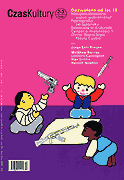Fotografia uratowała mi życie - Z Nan Goldin rozmawiają Adam Mazur i Paulina Skirgajłło-Krajewska
Photography Saved My Life.
Author(s): Paulina Skirgajłło-Krajewska, Adam MazurSubject(s): Photography
Published by: Stowarzyszenie Czasu Kultury
Keywords: Censored exhibition of photography by Nan Goldin in Warsaw; Personal overtone in Nan Goldin’s works; The motive of mirrors in art; Creating art as a from of therapy; Homophobic reactions of Polish people
Summary/Abstract: The exhibition of Nan Goldin’s photography, Devil’s Playground, held in Zamek Ujazdowski in Warsaw from 14 February to 14 April 2003 was surrounded by a scandal. Images presenting gay people in love turned out to be shocking enough for censors to label it as “X-rated”. During the press conference before the exhibition, the artist herself said that teenagers in particular should see her works because they may protect them against dangerous twists of fate, such as AIDS and suicide. At present, the people presented in the photographs live in these images only. Their sexual freedom drove them to lose their “games with the devil”. Presenting gay people is aimed at protecting adolescents who do not accept their sexual identity against the deadly “temptations of the devil”. Violetta Sajkiewicz stresses that without empathy and a personal perception of Nan Goldin’s art it is not possible to understand it. She focuses on human relations and the people she takes photographs of are very close to her heart. “She stole the souls of her models long before she pressed the shutter release and that is why we can access the most intimate moments of their lives”. This shows that the artist’s involvement may find a reflection, like that of a mirror, in the viewer’s involvement. The motive of mirrors seems to play a crucial role in Nan Goldin’s photographs. It is more obvious in her self-portraits, such as the Self-portrait in Blue Bathroom in which the artist is looking at herself in a mirror or the Self-portrait in which she has an expression of unusual absent—mindedness on her face. This simultaneous relation between the model and the viewer, “an androgenic duality”, is present even when Goldin is not in the picture. It is not surprising that for Nan Goldin photography is a form of therapy. As she has declared herself, photography saved her life. The suicide of her sister was a turning point: with her camera she began to record a turbulent autobiography in which tragic moments
Journal: Czas Kultury
- Issue Year: 2003
- Issue No: 02-03
- Page Range: 46-49
- Page Count: 4
- Language: Polish
- Content File-PDF

